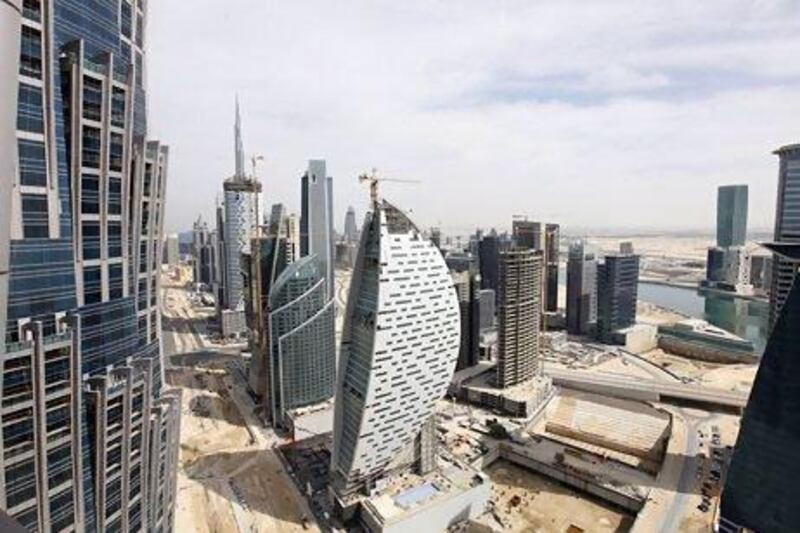Skeletal and empty, their once-bustling cranes hang motionless, as though in silent testimony to difficult times past.
Amid the growing signs in Dubai of a strong recovery from the global financial crisis that hit property markets hard worldwide, the view from the 124th floor of Burj Khalifa shows a number of office blocks and apartment buildings that have remained unfinished.
It is a seemingly incongruous sight, given the news from local estate agents that some house prices in the emirate are rising faster than those in prime central London areas. However, a series of announcements made last week by Sheikh Mohammed bin Rashid, Vice President of the UAE and Ruler of Dubai, that billions of dirhams is to be invested into new property developments in the city lends weight to their arguments.
And with confidence flooding back into the emirate's property industry, attention is once again turning to the so-called "ghost developments" that haunt parts of the city.
Property professionals report an increase in the number of inquiries they are receiving about restarting stalled projects.
"We have been speaking to a couple of companies interested in restarting stalled schemes," says Tareq Abu-Sukheila, the principal of the Abu Dhabi office for the architecture firm Gensler.
"We evaluated three buildings, which were all feasible. We found that it was up to 40 per cent cheaper for a particular client to move to a partially built scheme rather than starting again from scratch.
"I am sure it is happening in the marketplace and will happen a lot more as the market begins to improve."
Laith Haboubi is the business development director at the concrete repair systems specialist Mapei. His company is expecting an increase in orders from developers keen to restart work on stalled towers. "We're getting more and more calls about this issue," he says.
"I think it's very likely over the next couple of years that people will start looking to bring these stalled schemes back into use. During the heyday of construction around 80 per cent of our business was concerned with new construction and 20 per cent repairs.
"Then, during the downturn, these proportions swapped around - although, obviously, our workload was much smaller.
"Now we're seeing a gradual change to construction and I think it is very likely that more of our work will be concerned with abandoned buildings."
Cluttons, an international property broker, reports a surge in demand for feasibility studies on projects in Dubai over the past few months. "Cluttons has witnessed a noticeable pickup in feasibility activity and due diligence being undertaken by developers and investors into projects currently on hold or previously cancelled, with the numbers being under close scrutiny once more," the company reported.
Before Sheikh Mohammed's announcement last week, there had already been a number of developers picking up their shovels again this year.
Nakheel announced the restart of projects on the Palm Jumeirah townhouses and Jumeirah Park villas. Dubai Properties Group restarted work on 348 villas and townhouses at its Mudon project in Dubailand. And Emaar is developing 253 villas on land once earmarked for the Dubailand project after buying it from Dubai Properties this summer.
But many others are still on hold. Several blocks in Business Bay including Sheth Estate's striking Iris Bay, which has remained topped out but has been incomplete since work stopped last year; some of the blocks scheduled to be built by subcontractors at Dubai Sports City off Emirates Road; and a number of stalled projects in Abu Dhabi including Tameer Towers on Reem Island.
So what are the main problems with bringing such developments back to life?
Obviously, a lack of funding is still the key factor holding back most halted Dubai projects. However, there are also some other issues.
Firstly, demand from investors has changed over the past five years.
"With the announcement of all these new projects there is surely the potential for others started before the downturn to carry on," says Mario Volpi, the head of sales and leasing at Cluttons' Dubai office. "It would go a long way to improving confidence in Dubai.
"However, most of these new schemes have been leveraged off existing popular developments. Also, a lot of these stalled schemes were for office towers or apartments while the main demand we are seeing at the moment is for villas which are easier to build in smaller stages," adds Mr Volpi.
And architects point out that changing the use of these schemes is not always straightforward.
"As architects, our role is often to look at bringing these buildings back into use again. It depends on the use of the building - if it is meant to be a commercial office building or residential - it's what's feasible with the site," says Mr Abu-Sukheila.
"There are major issues with the use of the building. If it was designed as housing, it is much easier to convert it to offices than the other way around. And legal issues can be a hurdle," he adds.
"Under the occupancy laws, only a certain number of people can go into an apartment unit; for offices this is higher. Also there are parking issues - you need many more for an office. And there are also issues with cooling."
Mr Haboubi also points out that the longer these buildings are left, the more expensive they will be to bring back into use.
"As a big repair consultant we always say it is much more cost-effective to do these things early," he says.
"We say that there is a 'law of five' for concrete - for every five years left without protection, the cost to bring it back is five times more [than] within five years."
[ lbarnard@thenational.ae ]





